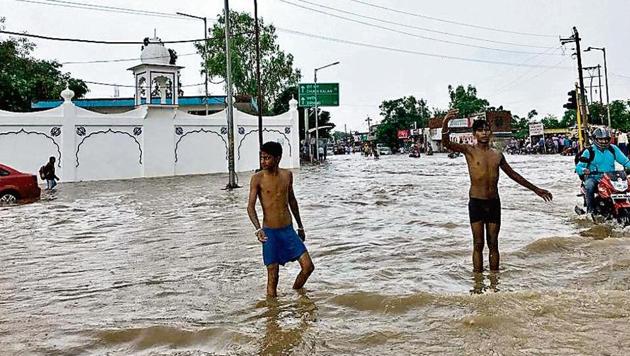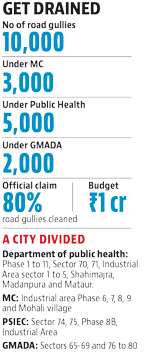HT Spotlight: Mohali ready or not, rains will tell
Though the Mohali MC claims it has cleaned 80% of the road gullies and is ready to take on the monsoon, the ground reality seems shaky and the councillors are worried.
Last year, Mohali bore the brunt of the extreme rain event on August 21. In less than an hour, its roads got flooded, and in two hours its houses were inundated. Life came to a halt as water poured into cars and people found themselves marooned with no help in sight. Much debate raged about the poor drainage of Mohali, but a year on, assurances is all that the Municipal Corporation has been giving even though its claims of being rain ready were washed out by water-logging during the recent showers.

The municipal corporation claims it has cleaned around 80% to 85% of the road gullies, and work is on to clear the rest. But when the MC house met last fortnight, the only issue that most councillors raised was that of choked drains and gullies.
N-Choe, which flows in the middle of Mohali, has not been cleaned. Many councillors expressed their fear that it will not be able to sustain heavy rains and the filthy water would flow into the town. However, the Mayor, Kulwant Singh, boastfully assured, “Let the monsoon come.”
A major challenge the city faces in preparing for the monsoons is the multiplicity of agencies managing different areas. The city is governed by four agencies--the Municipal Corporation, Punjab Water Supply and Sanitation Department, Greater Mohali Area Development Authority (GMADA) and Punjab State Industries and Export Corporation (PSIEC)--which makes it difficult to draw a city-wide plan.
The trouble spots
Mataur Village, Sector 70: Congested streets, choked drains and lack of space to construct additional drains makes this village a nightmare in the rains. At some places, people have encroached upon drains or gullies, while at others, they have been blocked by construction material. The corporation cleans the places it can access easily and leaves the rest. During monsoon, sewerage lines also get blocked and start overflowing.
Phase 4 and Phase 5, Phase 3B1, 3B2, Phase 11: Structural flaws cause a monsoon mess in Phase 4 and Phase 5. Many houses in these areas are low-lying slopes and no agency has any remedy to stop water flowing into them. Residents also blame unplanned carpeting of roads, which raises their level and causes water to collect on the sides. At places, it also enters houses.

Water-logging is a routine affair in Phase 3B1 and 3B2. Geographers say the natural lay of the land makes it prone to flooding as water from Chandigarh flows down to this part of Mohali.
Residents of Phase 11 get inundated due to the poor cleaning of the Lakhnour Choe. Since the choe is choked, water level rises and enters the houses in Phase 11.
Industrial Area: Though the Mohali industrial area is home to a large number of industrial and IT units, there is no check on builders dumping their debris in its drains and road gullies. A minor shower is all that it takes to flood this area. Often, the sewerage lines also get blocked but PSIEC is yet to come up with any remedial measures.
Solutions to stay dry
Audit the drainage system, stop concretisation : MS Aujla, former director of town planning, Punjab
Our drainage system cannot handle the increased intensity of rain spells. The carrying capacity of the drainage system should be updated. It is time we conducted an audit of the drainage system keeping the climate change and extreme events in mind. Unfortunately, the unplanned development has led to concretisation. There is little ‘kucha’ space left for the percolation of water. Second, the natural flow of the rainwater has been either diverted or stopped by roads and other buildings. There were old areas in Mohali like Mataur village, which don’t have any scope for improvement of the drainage system. The outer areas should have been made in a way to handle the pressure of water flowing out from this area.
Don’t raise the road levels : NS Kalsi, retired Executive Engineer, GMADA
The Mohali Municipal Corporation and Greater Mohali Area Development Authority (GMADA) are to be blamed for water-logging in certain areas of Mohali. There was no water-logging over 20 years ago as the roads were not above the plinth level. Now roads dividing sectors are above the plinth level of houses, resulting in rainwater flowing into residences. Authorities have been flouting the norms by laying pre-mix without digging up the roads. Consequently, the height of the roads keeps increasing.
Mohali has two natural choes in Patiala ki Rao (behind Balongi) and N-choe passing through the PCA stadium, Phase 9, 10, and Sector 67. These are sufficient to drain out water during monsoon provided the natural flow of water is not obstructed.






